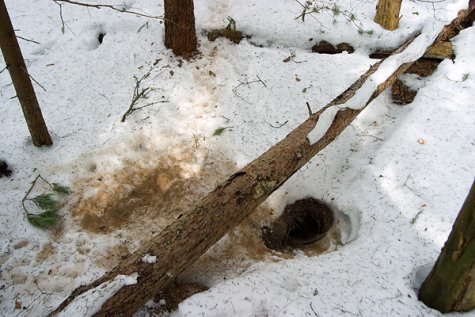Badgers starting to come out from dens
Photo: Sven Zacek, zacekfoto.ee
Translation: Liis
Badger; European badger Mäger Meles meles
At the end of November, with the arrival of a permanent snow cover and cold weather, all turned quiet around the badger dens, or setts, and the sett openings, some 20 centimetres in diameter, were blocked with leaves and moss. Now the nest is being aired in pleasant weather, and the badgers have "fresh air bath” walks around the sett.
The socially living badgers spend the greater part of their life underground, in winter in large and old setts (some setts can be inhabited for a hundred years) where even several families can live together. The setts are lined with leaves and moss. During the winter sleep or hibernation they still move around in the tunnel system of the den, change places to avoid stiffening, and when needed, visit side branches of the tunnels on „business“ – a badger holds itself to be a cleanly animal. The body functions in the organism are slowed down during winter, but a badger can lose up to half of its autumn body weight. In autumn a properly fattened male badger – bigger than the female – can weigh up to sixteen kilos. The juveniles are smaller, around six kilos.
For female badgers it is the time for giving birth. The new-born are blind, grey and with a silky fur. The eyes open at five weeks old and the mother brings them out from the sett after eight weeks, in April. Badgers are not very fertile, generally the litter has two-three cubs. The female bears the next litter sometimes only after some years since the newborn are dependant on the her until autumn, but often the whole first winter.
The setts are built in hilly, sandy landscapes where the groundwater is deep down. The hillocky landscape of South Estonia comes to mind, but badgers are everywhere on the mainland – densely or more sparsely. Badgers inhabited Saaremaa only about fifty years ago; now a vital population has developed there. As burrow sites they have started using the foundations of outbuildings, causing some frustration among owners.
Their abundance is estimated at more than three thousand individuals.









